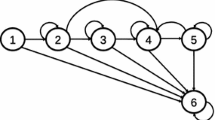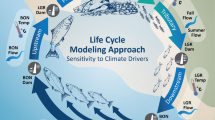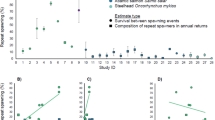Abstract
The Great East Japan Earthquake may have resulted in increased mortality of artificially propagated chum salmon fry (2010 year class) from Iwate Prefecture (CSI), both in the hatchery and after release. Individuals from the 2010 year class will return in 2014–2015. To evaluate the potential for future issues associated with the effects of the earthquake, we simulated CSI population dynamics using a model that incorporated stratified earthquake-influenced survival rates λ l (l = 0.00−1.00 at intervals of 0.25) under various scenarios. Under laissez-faire scenarios (median exploitation rate E Med) under low post-release survival rate S Low and all λ l , the median number of hatchery-released fry \(H^{\prime }_{t}\) did not reach the target H * in 2014 and 2015. The probability P j,t of not meeting the targets was 0.56−1.00 (2014) and 0.79−1.00 (2015). Meanwhile, with simulation of a low exploitation rate, S Low, and a higher λ l (0.50), the P j,t in 2014 and 2015 was 0.00−0.17 and 0.21−0.72, respectively. Under S Med and S High, \(H^{\prime }_{t}\) reached H * at λ l (>0.50) regardless of E l , and the cumulative catch varied primarily with S l . Our results suggest that simulations can provide a method of predicting potential issues and can offer insight into strategies to minimize future problems.






Similar content being viewed by others
References
Ogawa G, Shimizu Y (2012) Rehabilitation of artificial hatchery program of chum salmon in Iwate Prefecture after the Great East Japan Earthquake and stock recovery-related problems. Nippon Suisan Gakkaishi 78:1040–1043 (in Japanese)
Iwate Prefecture (1973−2008) Data relating salmons in Iwate Prefecture. Iwate-ken nourinnsuisann-bu suisann shinnko-ka, Morioka (in Japanese)
Saito T, Nagasawa K (2009) Regional synchrony in return rates of chum salmon (Oncorhynchus keta) in Japan in relation to coastal temperature and size at release. Fish Res 95:14–27
Healey MC (1982) Timing and relative intensity of size-selective mortality of juvenile chum salmon (Oncorhynchus keta) during early sea life. Can J Fish Aquat Sci 39:952–957
Saito T, Kaga T, Hasegawa E, Nagasawa K (2011) Effects of juvenile size at release and early marine growth on adult return rates for Hokkaido chum salmon (Oncorhynchus keta) in relation to sea surface temperature. Fish Oceanogr 20:278–293
Harada Y, Matsumiya Y (1992) A theoretical study on resource enhancement by stocking, with special reference to its intergenerational effects. Nippon Suisan Gakkaishi 58:1833–1842 (in Japanese with English abstract)
Iwata M, Komatsu S (1984) Importance of estuarine residence for adaptation of chum salmon (Oncorhynchus keta) fry to seawater. Can J Fish Aquat Sci 41:744–749
Francis RICC, Shotton R (1997) “Risk” in fisheries management: a review. Can J Fish Aquat Sci 54:1699–1715. doi:10.1139/f97-100
Watanabe K, Sakuramoto K, Sugiyama H, Suzuki N (2011) Dynamics of two sailfin sandfish (Arctoscopus japonicas) stocks in the Sea of Japan, and their management. Can J Fish Aquat Sci 68:458–468
Irvine JR, Tompkins A, Saito T, Seong KB, Kim JK, Klovach N, Bartlett H, Volk E (2012) Pacific salmon status and abundance trends 2012 update. NPAFC Doc 1422:1–90
Pope JG (1972) An investigation of the accuracy of virtual population analysis using cohort analysis. ICNAF Res Bull 9:65–74
Fukuwaka M, Sato S, Yamamura O, Sakai O, Nagasawa T, Nishimura A, Azumaya T (2010) Biomass and mortality of chum salmon in the pelagic Bering Sea. Mar Ecol Prog Ser 403:219–230
Iwate-ken Sake-masu zoshoku kyoukai (2010–2013) Annual report. Iwate-ken Sake-masu Zoshoku Kyoukai, Morioka (in Japanese)
National Salmon Resources Center (1989–2008) Salmon data base. Hokkaido National Fisheries Research Institute FRA, Sapporo (in Japanese)
Ishida K (1991) Influence of hydrographic conditions on catch fluctuations of adult chum salmon (Oncorhynchus keta), along the coast of Iwate. Bull Jpn Soc Fish Oceanogr 55:105–113 (in Japanese with English abstract)
Inoue Y, Nagahara S, Watanabe T, Ishida K (1987) Variation of fish behavior influenced by constration of the set-net. Nippon Suisan Gakkaishi 53:695–698 (in Japanese with English abstract)
Ueno Y (1991) Migration of mature chum salmon along Iwate Prefecture coast estimated by tagging experiments. Fish Sci 57:1445–1452
Ueno Y (1992) Deepwater migrations of chum salmon (Oncorhynchus keta) along the Pacific coast of northern Japan. Can J Fish Aquat Sci 49:2307–2312
Miyakoshi Y, Urabe H, Aoyama T, Sakamoto H, Ando D, Kasugai K, Mishima Y, Nagata M (2012) The occurrence and run timing of naturally spawning chum salmon in northern Japan. Environ Biol Fish 94:197–206
Morita K, Takahashi S, Ohkuma K, Nagasawa T (2013) Estimation of the proportion of wild chum salmon Oncorhynchus keta in Japanese hatchery rivers. Nippon Suisan Gakkaishi 79:206–213 (in Japanese with English abstract)
Kaeriyama M, Qin Y (2014) Biological interactions between wild and hatchery-produced Pacific salmon. Nova Science Publishers Inc, Salmon, pp 223–238
Kitada S (2014) Japanese chum salmon stock enhancement: current perspective and future challenges. Fish Sci 80:237–249
Kishi MJ, Kaeriyama M, Ueno H, Kamezawa Y (2010) The effect of climate change on the growth of Japanese chum salmon (Oncorhynchus keta) using a bioenergetics model coupled with a three-dimensional lower trophic ecosystem model (NEMURO). Deep-Sea Res II 57:1257–1265
Adbul-Aziz OI, Mantua NJ, Myers KW (2010) Potential climate change impacts on thermal habitats of Pacific salmon (Oncorhynchus spp.) in the North Pacific Ocean and adjacent seas. Can J Fish Aquat Sci 68:1660–1680
Acknowledgments
We thank Yuichi Shimizu and Shou Sasaki of the Iwate Prefectural government and Naruto Kogarumai, Fumihisa Takahashi, Yukihisa Hirabayashi, and anonymous reviewers for their useful advice and support.
Author information
Authors and Affiliations
Corresponding author
Rights and permissions
About this article
Cite this article
Watanabe, K., Sasaki, K., Saito, T. et al. Scenario analysis of the effects of the Great East Japan Earthquake on the chum salmon population-enhancement system. Fish Sci 81, 803–814 (2015). https://doi.org/10.1007/s12562-015-0896-1
Received:
Accepted:
Published:
Issue Date:
DOI: https://doi.org/10.1007/s12562-015-0896-1




